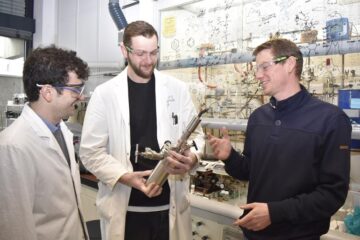Birds that sing with their wings to woo

In the courtship dance of a male South American bird, the Club-winged Manakin, Machaeropterus deliciosus, rubbing and vibrating specialized wing feathers together creates a courting melody to attract their mates, according to a report in Science.
Since Darwin proposed his theories of selection and evolution, it has been posed that sounds made by the feathers of some birds evolved by sexual selection. Richard O. Prum, the William Robertson Coe Professor of Ecology and Evolutionary Biology at Yale, and his former student Kimberly S. Bostwick, a curator in the birds and mammals division of Cornell’s Museum of Vertebrates and a research associate in the Department of Ecology and Evolutionary Biology, describe a mechanism unique among vertebrates that supports this theory.
Using high-speed digital video recordings of the courtship displays, they show that males produce sustained, harmonic tones by rubbing together secondary wing feathers. These highly specialized feathers have shafts that are enlarged hollow, club-like structures. They are bent and slightly twisted so that the ends can touch each other creating a ringing “Tick–Tick–Ting” song when rubbed together.
As loud as a typical bird vocal song, the wing song is easily heard tens of meters away. The “tick” notes are sharp clicks, and the “ting” is a sustained, violin-like note that lasts about one third of a second. “It is a bit like running your finger over a comb,” said Prum, who as thesis advisor of the project was initially skeptical of the “comb” idea.
“We ruled out a lot of hypotheses” said Bostwick, “but when I realized that the wing feathers were twisted in a way that forced them to rub, I knew we had something.”
“The extensive modification of feathers in these unusual structures implies a high degree of selective evolutionary pressure,” said Prum. “It must be a very romantic song.”
Bostwick who studied sexual attraction behavior in several species of this family, previously reported one that sings less spectacularly, but claps and has a courting dance that resembles Michael Jackson’s “moonwalk”.
“Nature is more miraculous than we know. It is amazing that we can walk into the woods, or jungle, and find this kind of beauty and diversity,” she said. A National Science Foundation Grant funded this study.
Media Contact
More Information:
http://www.yale.eduAll latest news from the category: Life Sciences and Chemistry
Articles and reports from the Life Sciences and chemistry area deal with applied and basic research into modern biology, chemistry and human medicine.
Valuable information can be found on a range of life sciences fields including bacteriology, biochemistry, bionics, bioinformatics, biophysics, biotechnology, genetics, geobotany, human biology, marine biology, microbiology, molecular biology, cellular biology, zoology, bioinorganic chemistry, microchemistry and environmental chemistry.
Newest articles

Lower dose of mpox vaccine is safe
… and generates six-week antibody response equivalent to standard regimen. Study highlights need for defined markers of mpox immunity to inform public health use. A dose-sparing intradermal mpox vaccination regimen…

Efficient, sustainable and cost-effective hybrid energy storage system for modern power grids
EU project HyFlow: Over three years of research, the consortium of the EU project HyFlow has successfully developed a highly efficient, sustainable, and cost-effective hybrid energy storage system (HESS) that…

Safer alternative for an explosive reaction
The chemical industry has been using a reaction with explosive chemicals for over 100 years – now Mülheim scientists have discovered a safer alternative. The Ritter Group of the Max…





















